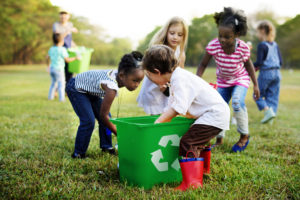America’s neighborhoods are littered with Halloween staples like toothy pumpkins, cobwebbed trees and dangling skeletons, ready to frighten trick-or-treaters. Alongside these front yard decorations, America’s recycling bins are experiencing a poltergeist.
Materials like glass and certain types of plastic, once commonplace in single-stream recycling, are now ghosts in the bins of the many systems that used to accept them. Lost souls doomed to wander landfills for all eternity. Other bins have disappeared entirely.
Communities across America are increasingly reducing or abandoning curbside recycling. These programs are one of the most convenient and effective ways for Americans to recycle materials from their homes — which amounts to around 800 to 1,000 pounds of recyclables each year. So when programs close, it’s a major problem for American recycling — and for the Americans who can’t afford to drive upwards of 160 miles to take recyclables to a facility instead.
It’s a symptom of a chilling reality: America’s recycling system is disappearing. There are thousands of local systems that all have their own sets of rules on what can be recycled, generating mass confusion. Google searches for how to recycle paper and plastic at home have doubled in the last year alone.
There are thousands of local systems that all have their own sets of rules on what can be recycled, generating mass confusion.
What’s worse, the confusion increases recycling contamination. Every time we mistakenly toss a “maybe” in the bin — a frequent behavior that 40 percent of Americans admit doing — it can break the recycling rules, increasing the chances that the whole lot won’t be recovered and will head to the landfill instead.
When Oregon, OH, suspended its curbside program this April, City Administrator Mike Beazley said, “I guess what I feel worst about, we were part of the generation that went, ‘when in doubt, put it in the bin.’ We were wrong. That market changed, and that world changed.”
Hundreds of communities nationwide have shuttered their recycling programs, limited acceptable recyclables or suspended curbside programs.
The horror stories are growing in number:
- Sunrise, FL, takes curbside recycling to an incinerator instead.
- Silver City, NM, canceled all recycling after dumping curbside recycling in landfills.
- Kankakee, IL, ended its curbside program after finding that 85 percent of the 584 tons of the community’s recycling were thrown out due to contamination with trash.
No one deserves to be punished for wanting — but not knowing how — to recycle. It’s not right that our wishful thinking works against us in our current system, and no amount of chanting “recycling” (or “Beetlejuice” for that matter) can make a functioning system magically appear.
No one deserves to be punished for wanting — but not knowing how — to recycle.
So those who can act to solve this crisis, must.
CPG is working toward a more sustainable future. To start, 100 percent of the 25-largest CPG companies have made commitments to increasing recyclable content, minimizing packaging or reusing material — 80 percent will be fully recyclable by 2030.
Dozens of CPG companies partner with How2Recycle, a standardized labeling system that gives brief directions for recycling, like “rinse and replace lid” or “remove label before recycling.”
CPG companies also aid the Recycling Partnership to help consumers learn their local recycling rules.
But the industry’s impact can only go so far when the recycling rules change city to city, county to county — and there are more than 9,800 systems to contend with. We, and our environment, deserve better.
When 75 percent of Americans say they’re very or extremely concerned about the environment, as Consumer Brands’ research found, they’re entitled to a recycling system that works — everywhere. But if we don’t solve for our broken system now and its thousands of rules, your neighborhood bins will truly be the ghosts of Halloween past.




